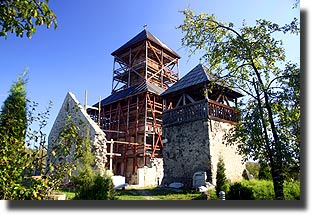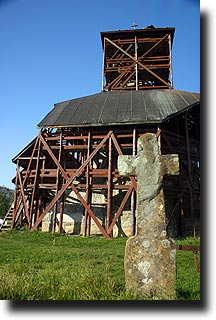 Before
we wandered the halls of the amazing Corbin Castle, we had journeyed even
farther back in time to the delightful Church in Densus. The church
one sees today was built in the 11th or 12th century on the ruins of a
Roman soldier's mausoleum. Many of the Roman columns and sarcophogus
pieces have been used in the construction of the church. Before
we wandered the halls of the amazing Corbin Castle, we had journeyed even
farther back in time to the delightful Church in Densus. The church
one sees today was built in the 11th or 12th century on the ruins of a
Roman soldier's mausoleum. Many of the Roman columns and sarcophogus
pieces have been used in the construction of the church.
Though the church was never made a mosque (so far as archeological evidence suggests), many of its religious images were defaced. Battles of ideology between Orthodox Slavs and Catholic Hungarians make a mark, as well, during the 15-17th centuries. The church is now a Romanian Heritage Site and restoration efforts are underway. Many of the frescoes on the interior have been restored. One from the 15th century shows a flayed St. Bartholemew (completely eerie). Many also show the marked influence of the Byzantine Orthodox church. Romania is one of those countries that bears the mark of so many people and periods that it is often difficult to say where one influence begins and another ends. This little church, to us, is the embodiment of survival given the incredible dynamics of change.
|
 The
history of the church is an amazing example of how history gives and takes
to make her own story: Dacians lived in the area since the 3rd century
bce (see our next section on Sarmizegetusa). The Romans supressed
these people by 100 ce. This is when the mauoleum was built.
Within 200 years, there were threats of invasion by Gothic tribes.
There were christians among the Roman soldiers coming north to defend the
territory against these invading tribes. The mausoleum was
converted to a small christian church sometime during this period.
During the 4-12th centuries, waves of Goths, Huns, Slavs and Tartars flooded
across this area. The church that stands today was constructed
sometime at the end of this time period using stones from ancient Dacian-Sarmizegetusa.
The 12th-14th centuries saw an influx of Ottoman influence.
The
history of the church is an amazing example of how history gives and takes
to make her own story: Dacians lived in the area since the 3rd century
bce (see our next section on Sarmizegetusa). The Romans supressed
these people by 100 ce. This is when the mauoleum was built.
Within 200 years, there were threats of invasion by Gothic tribes.
There were christians among the Roman soldiers coming north to defend the
territory against these invading tribes. The mausoleum was
converted to a small christian church sometime during this period.
During the 4-12th centuries, waves of Goths, Huns, Slavs and Tartars flooded
across this area. The church that stands today was constructed
sometime at the end of this time period using stones from ancient Dacian-Sarmizegetusa.
The 12th-14th centuries saw an influx of Ottoman influence.
